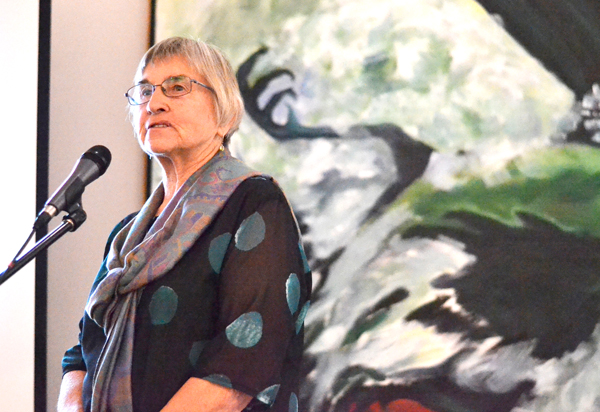Rigmor Clarke has seen a lot of sights.
The Swedish-born artist, who has lived for the past several decades in Shell Lake, can pinpoint the moment she first observed the world as a painter would.
While visiting a lake in the northern part of her home country at five years old, She looked out and saw the reflection of the hills, the shadow on the water, the shadow under the water and the floor of the lake.
“I realized what I saw, and I was really excited,” she said in an interview a few hours before the opening of her retrospective at the Mann Art Gallery Friday.
“After that, I couldn’t stop looking at things.”
Friday was a chance for Rigmor to take in another sight — a gallery dedicated to her life’s work.
After taking in, for the first time, the retrospective show, Rigmor became emotional.
“It’s a dream come true,” she said. “I don’t think anybody will ever know how much it means to me but myself. It’s a long time coming.”
Rigmor said she always wanted to be a painter. She got her first set of oils when she was 10. She was inspired by the landscapes painted by Nordic painters hanging on the walls of museums she visited as a child.
“I was drawn towards those painters,” she said.
When Clarke was 14, her family moved to BC. When she was in her early 20s, she took a train as far as she could, and arrived in Shell Lake, Sask. She met her husband, John Clarke, moved to his farm and started a family.
While she still pursued art, it wasn’t until Rigmor turned 40 that she decided to pursue art full time. She took art classes with Bob Christie, Myles McDonald and George Gleen, and took art workshops at Emma Lake.
Like that time she was young, Rigmor was inspired by a sight seen over water. According to a profile written by the Saskatchewan Arts Alliance, she had an epiphany while on a canoe trip on the Churchill River.
“I felt like I was home,” she said Friday.
“It was very much like Northern Sweden where I was raised. Sweden is very much like Saskatchewan.”
Northern Saskatchewan, she said, looks much like northern Sweden, while the plains of the southern prairies reminiscent of the Swedish lowlands.
The similarities Rigmor sees don’t end there. The Mann Art Gallery features a sample of her paintings of ravens. Ravens play an important role in Rigmor’s work — she even named her Shell Lake Quonset studio the Forest Raven Art Studio.
She first became fascinated with the raven when she was growing up and reading Nordic mythology. When she came to Canada, she learned the raven also featured prominently in the oral traditions of Indigenous people. As she explored further, she discovered more and more stories about the raven from the northern portions of the world’s continents.
That inspired a series of paintings.
“I did more research and decided to make a series of paintings about the raven through the Nordic hemisphere, right around the world,” she said.
“There’s one from Siberia, from China, and the Norse raven with the Viking ship because the Vikings found Iceland by following the raven. It always intrigued me, which is why I called my studio the forest raven art studio.”
The motion-filled paintings of ravens are placed in the Mann Gallery exhibition alongside another signature of Rigmor’s work: images of storm clouds meeting choppy waters lapping against tree-covered northern shores.
Those dramatic, and often quite large, scenes are paired with some of Rigmor’s smallest, rawest works, her plein air paintings done on site in the bush of Saskatchewan’s north.
“The small, plein air paintings are based on the landscape, and the large paintings are based on the plein air paintings,” she explained.
“If I painted the large paintings the same way I painted the small paintings, I would have to use a brush that is one foot wide. It’s impossible. The big ones have more detail. They take a life of their own, but I hope that the ambience is the same.”
Rigmor explained further. The images, she said, beg to be painted on grander and grander scales.
“The way I pick the ones to paint is the ones that have to be big. They say ‘make me bigger, make me bigger,’” she said.
“You feel like it’s going to need more space. Like the Nordic country, it’s so big, so powerful.”
The urge to paint those scenes is not one Rigmor could explain. Like the paintings themselves, her desire to work takes on a life of its own.
“I don’t think that is something you can control,” she said. “It’s like a singer has to sing, a dancer has to dance. A painter has to paint.”
As the interview came to an end, Rigmor thought for a second.
“Saskatchewan is very beautiful,” she said.
“It’s got tremendous beauty. The variation from the south — I’ve seen the prairies. If I lived on the prairies, I would build on the emptiest, loneliest hill and not let anything grow more than two feet tall. Because the sky comes at you. It’s all around you. It’s very powerful.”
She smiled.
“But I’m a bush painter, not a sky painter.”


